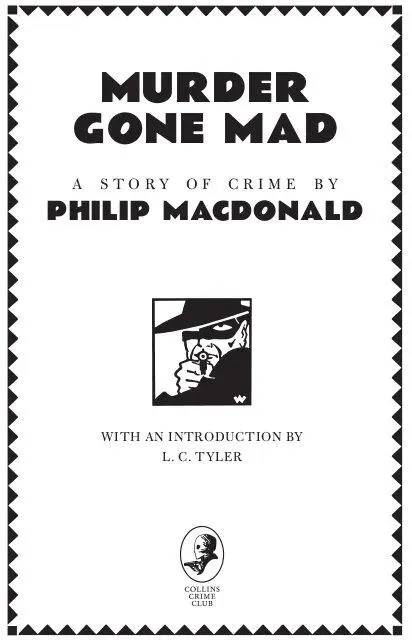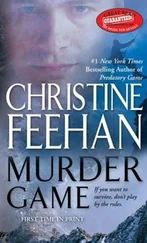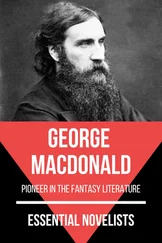‘THE DETECTIVE STORY CLUB is a clearing house for the best detective and mystery stories chosen for you by a select committee of experts. Only the most ingenious crime stories will be published under the THE DETECTIVE STORY CLUB imprint. A special distinguishing stamp appears on the wrapper and title page of every THE DETECTIVE STORY CLUB book—the Man with the Gun. Always look for the Man with the Gun when buying a Crime book.’
Wm. Collins Sons & Co. Ltd., 1929
Now the Man with the Gun is back in this series of COLLINS CRIME CLUB reprints, and with him the chance to experience the classic books that influenced the Golden Age of crime fiction.
Copyright Copyright Introduction Chapter I Chapter II Chapter III Chapter IV Chapter V Chapter VI Chapter VII Chapter VIII Chapter IX Chapter X Chapter XI Chapter XII Chapter XIII Chapter XIV Chapter XV Chapter XVI Chapter XVII Chapter XVIII Chapter XIX Footnote The Detective Story Club About the Publisher
COLLINS CRIME CLUB
An imprint of HarperCollins Publishers Ltd
1 London Bridge Street
London SE1 9GF
www.harpercollins.co.uk
First published for The Crime Club by W. Collins Sons & Co. Ltd 1931
Copyright © Estate of Philip MacDonald 1931
Introduction © L. C. Tyler 2017
A catalogue copy of this book is available from the British Library.
This novel is entirely a work of fiction. The names, characters and incidents portrayed in it are the work of the author’s imagination. Any resemblance to actual persons, living or dead, events or localities is entirely coincidental.
All rights reserved under International and Pan-American Copyright Conventions. By payment of the required fees, you have been granted the non-exclusive, non-transferable right to access and read the text of this e-book on screen. No part of this text may be reproduced, transmitted, down-loaded, decompiled, reverse engineered, or stored in or introduced into any information storage and retrieval system, in any form or by any means, whether electronic or mechanical, now known or hereinafter invented, without the express written permission of HarperCollins.
Source ISBN: 9780008216351
Ebook Edition © December 2016 ISBN: 9780008216368
Version: 2016-11-23
Contents
Cover
Title Page
Copyright Copyright Copyright Introduction Chapter I Chapter II Chapter III Chapter IV Chapter V Chapter VI Chapter VII Chapter VIII Chapter IX Chapter X Chapter XI Chapter XII Chapter XIII Chapter XIV Chapter XV Chapter XVI Chapter XVII Chapter XVIII Chapter XIX Footnote The Detective Story Club About the Publisher COLLINS CRIME CLUB An imprint of HarperCollins Publishers Ltd 1 London Bridge Street London SE1 9GF www.harpercollins.co.uk First published for The Crime Club by W. Collins Sons & Co. Ltd 1931 Copyright © Estate of Philip MacDonald 1931 Introduction © L. C. Tyler 2017 A catalogue copy of this book is available from the British Library. This novel is entirely a work of fiction. The names, characters and incidents portrayed in it are the work of the author’s imagination. Any resemblance to actual persons, living or dead, events or localities is entirely coincidental. All rights reserved under International and Pan-American Copyright Conventions. By payment of the required fees, you have been granted the non-exclusive, non-transferable right to access and read the text of this e-book on screen. No part of this text may be reproduced, transmitted, down-loaded, decompiled, reverse engineered, or stored in or introduced into any information storage and retrieval system, in any form or by any means, whether electronic or mechanical, now known or hereinafter invented, without the express written permission of HarperCollins. Source ISBN: 9780008216351 Ebook Edition © December 2016 ISBN: 9780008216368 Version: 2016-11-23
Introduction
Chapter I
Chapter II
Chapter III
Chapter IV
Chapter V
Chapter VI
Chapter VII
Chapter VIII
Chapter IX
Chapter X
Chapter XI
Chapter XII
Chapter XIII
Chapter XIV
Chapter XV
Chapter XVI
Chapter XVII
Chapter XVIII
Chapter XIX
Footnote
The Detective Story Club
About the Publisher
INTRODUCTIONS, like prologues, are often best skipped. They are not, after all, what you have bought the book for and few good stories really need an explanation.
And yet, readers of this volume may welcome a short account of Philip MacDonald and his work, if only because after his death in 1980 his books quickly slipped from public view and information on him can be surprisingly difficult to find and sometimes contradictory. Even the year of MacDonald’s birth has for some reason become veiled in mystery. 1896, 1899, 1900 and 1901 are all quoted by reliable sources.
The question of his birth can be quickly cleared up. Census records show that he was born on 5 November 1900 into a family that was very much part of the British literary establishment. His grandfather was the Scottish novelist and poet, George MacDonald, whose pioneering fantasy writing influenced many other writers, including J.R.R. Tolkien, C.S. Lewis and indeed G.K. Chesterton. His father was the playwright and novelist Ronald MacDonald and his mother the actress Constance Robertson. At the time of his birth the family was living (with one servant) at 9 Rossetti Mansions, Chelsea. Later they moved (gaining an additional servant on the way) to 25 St Margaret’s Road, Twickenham, from where MacDonald attended St Paul’s School. During the First World War, he served in Mesopotamia, though again details are hard to come by. His publisher after the war claimed he had served as a trooper in a ‘famous cavalry regiment’ but never thought to say which one and, to the best of my knowledge, nobody has subsequently identified it for certain. (It may have been the Machine Gun Corps Cavalry.) Whichever regiment it was, and whatever action he saw, MacDonald made good use of his experience in one of his earliest novels, Patrol (1927), in which a cavalry troop finds itself lost in the desert. It is told very much from the point of view of the ordinary soldier—the only officer is already dead at the start of the tale, having failed to impart to his second-in-command their current location or the object of the mission. Only the bravery and common sense of the troopers can see them through to possible safety—it is apparent where in the military hierarchy MacDonald’s sympathies lay.
His earliest publication was the perhaps unfortunately named Ambrotox and Limping Dick (1920), written jointly with his father under the pen name Oliver Fleming. He would later write variously as Anthony Lawless, Martin Porlock, W.J. Stewart and Warren Stewart. The first book under his own name however was The Rasp, which was published by Collins in 1924 and introduced his main series protagonist, gentleman detective and scholar Colonel Anthony Ruthven Gethryn . The Rasp was an immediate success and was later made into a film. Other crime novels followed in rapid succession. In 1931 MacDonald published no fewer than seven: four under his own name, two as Lawless and one as Porlock. In the same year he moved to Hollywood with his new wife, the author F. Ruth Howard, and started a career as a screenwriter, both adapting his own work and writing original film scripts. These last included contributions to popular series such as Charlie Chan and Mr Moto . He also adapted Daphne du Maurier’s Rebecca and Agatha Christie’s short story ‘Philomel Cottage’ (as Love from a Stranger ).
Читать дальше












